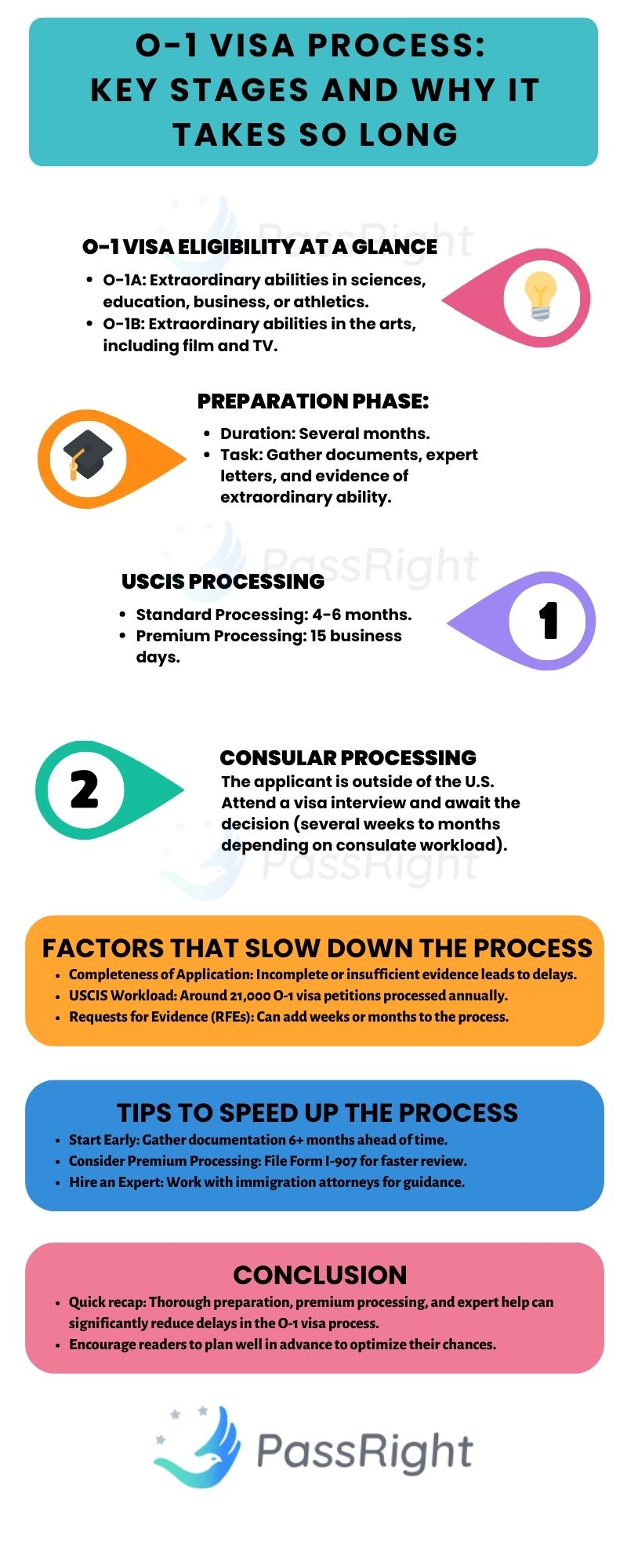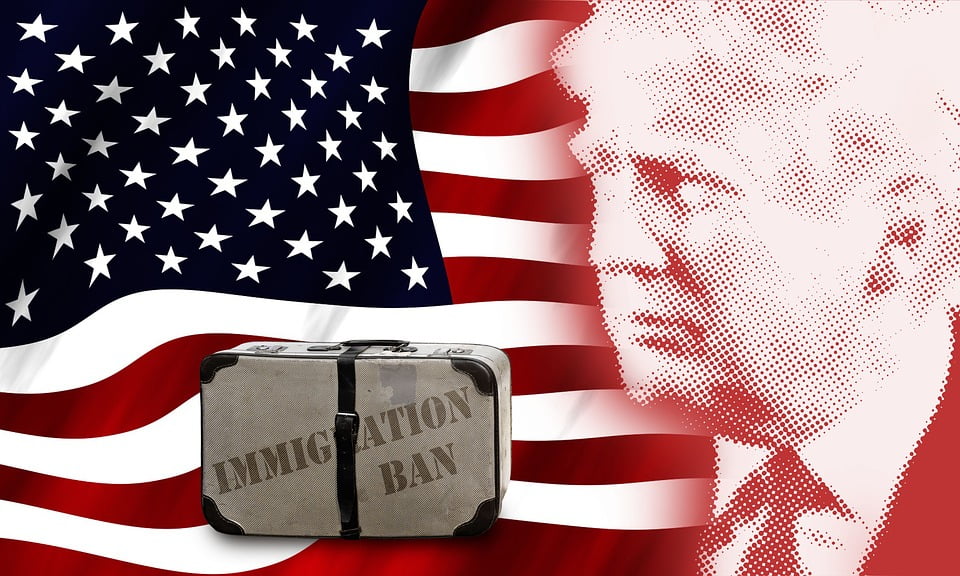Introduction
The O-1 visa is a very popular and interesting choice for those seeking to work in the United States in a field in which they have achieved extraordinary ability or achievement, such as the sciences, education, business, athletics, or the arts.
When applying for the visa, both applicants and their employers must understand the timeline for filing an O-1 case to manage expectations and employment start dates.
O-1 Visa Eligibility and Requirements:
The O-1 visa is a nonimmigrant visa for extraordinarily talented individuals who have achieved a level of national or international acclaim or have a record of extraordinary achievement.
The O-1 visa is broken down into two subcategories: the O-1A visa, which focuses on fields in the sciences, education, business, or athletics, and the O-1B visa, which is for those in the arts, including the television and film industry.
Defining Extraordinary Ability: O-1A Vs. O-1B
O-1A for Science, Education, Business, or Athletics
The Standard of Proof for O-1A beneficiaries is that they have sustained national or international acclaim and are among the small percentages who have risen to the very top of their field.
To apply for an O-1A visa in the fields of science, education, business or athletics, you must meet at least three of the below-mentioned criteria to demonstrate that you possess extraordinary ability based on a level of sustained national or international acclaim.
Extraordinary ability in science, education, business, or athletics means a degree of expertise that makes you one of a small percentage of individuals who have risen to the very top of your field. This is a higher standard to meet than the O-1B standard of proof.
O-1A Criteria & Required Evidence
In support of the O-1A visa for endeavors in the sciences, education, business, or athletics, you must provide evidence that you have received a major internationally recognized award (such as the Nobel Prize, Olympic medal, etc.), or if you have not received such an award you can still qualify by providing at least three of the following forms of evidence:
- Evidence of Awards and Honors: Other internationally recognized or nationally recognized awards in your field.
- Membership in Associations: Documentation of your membership in associations that require outstanding achievements as a criterion for membership.
- Published Material About Your Work: Articles, reviews, and other media coverage demonstrating your achievements and acclaim in your field.
- Original Contributions: Proof of significant original contributions of major significance in your field, such as patents, scholarly publications, or innovations.
- Authorship of Scholarly Articles: Articles you have written that have been published in major media or professional journals.
- Evidence of Critical Employment: Contracts or proof of a leading or critical role for distinguished organizations or establishments.
- High Salary or Remuneration: Evidence that you command or will command a high salary or other remuneration for your services compared to others in your field.
- Judging the Work of Others: Documentation showing you have judged the work of others in your field, either individually or on a panel.
The O-1A petition requires detailed and extensive supporting documentation to make a strong case. Applicants must also have a written advisory opinion or letter of recommendation from an expert or peer that can speak to the applicant’s talents. The advisory must come from a management organization or the appropriate labor union.
O-1B for the Arts
For O-1B artistic fields, individuals must meet at least three of the criteria outlined below. For creative endeavors, extraordinary ability means ‘distinction’, which is attained through a high level of achievement in the arts.
O-1B applicants with abilities in the arts need to show a high level of achievement or skill substantially above what is ordinarily encountered in the field. When demonstrating their talent, the applicant must prove their abilities are prominent, renowned, leading, or well-known in the arts or film industry.
O-1B Criteria & Required Evidence
The Standard of Proof for an O-1B (Arts) beneficiary is that they have sustained national or international acclaim and have achieved ‘distinction’ in the field of arts
Generally for Motion Picture and Television, the applicant should have a record of extraordinary achievement, as evidenced by a degree of skill and recognition significantly above that ordinarily encountered.
In support of the O-1B visa for the arts, you must provide evidence that you have received or been nominated for a significant national or global award or prize in your particular field (such as an Academy Award, Emmy, Grammy, or Director’s Guild Award), or if you have not received such an award you can still qualify by providing at least three of the following forms of evidence:
- Lead or Starring Participant in Distinguished Productions or Events: You have performed, and will perform, services as a lead or starring participant in productions or events that have a distinguished reputation (e.g., shown via critical reviews, advertisements, publicity releases, publications, contracts, or endorsements)
- National or Global Recognition: You have achieved national or international recognition for your achievements (e.g., shown via critical reviews or other published materials about you in major newspapers, trade journals, magazines, or other publications)
- Lead or Starring Participant for Distinguished Establishments: You have performed, and will perform, in the lead, starring, or critical role for organizations and establishments that have a distinguished reputation (e.g., shown by articles in newspapers, trade journals, publications, or testimonials)
- Major Commercial or Critical Acclaim: You have a record of major commercial or critically acclaimed successes (e.g., shown by indicators such as title, rating, standing in the field, box office receipts, motion pictures or television ratings, and other occupational achievements).
- Recognition for Achievements: You have received significant recognition for achievements from organizations, critics, government agencies, or other recognized experts in your field (e.g., testimonials clearly indicating the author’s authority, expertise, and knowledge of your achievements)
- High Salary or Remuneration: You either command a high salary or will command a high salary for your services compared to others in your field (as evidenced by contracts or other reliable evidence).
Written Advisory Opinions
A written advisory opinion from a peer group (including labor organizations) or someone with expertise in your area of ability must also be provided. Suppose the petition is for an individual with extraordinary achievement in motion picture or television. In that case, the consultation must come from an appropriate labor union and a management organization in your field.
Itinerary
An O-1B petitioner (agent or employer) must provide an explanation of the beneficiary’s events or activities in the U.S., including the beginning and ending dates for the events or activities, and a copy of any itinerary for the events or activities, as applicable. An itinerary is crucial for those performing on a tour or a series of events, performances, or competitions.
Timeline for O-1 Visa Processing with USCIS
The O-1 visa application has several steps, each with its timeline and requirements. Understanding each step helps applicants and their employers navigate the process effectively and sets realistic expectations for their visa journey.
Initial Preparation Phase
The initial preparation phase to gather the necessary documentation supporting the O-1 criteria can take several months. Employers sponsoring the visa should begin the application process at least six months before the intended employment start date. This will allow enough time to gather the necessary documentation and ensure the petition’s timely filing.
During the preparation phase, applicants must:
- Contact their employer, agent, or representative to begin the petition process and prepare and submit the correct forms.
- Work with immigration attorney to develop a winning strategy for your visa case and determine any weaknesses early on. For example, the terms of employment/representation, such as the salary, employment duties, worksite location, etc., should be agreed upon early on. Any issues should be resolved in the early stages.
- Put together supporting documentation to satisfy the O-1 criteria. This step is the most time-consuming, as the application requires detailed supporting documentation supporting the visa criteria, including letters of recommendation and advisory opinion letters from experts in your field to demonstrate that you qualify for the visa. Gathering comprehensive documentation is vital to the success of your application and can make or break your visa application.
- Review your O-1 petition filing to ensure you have provided all necessary documentation supporting the O-1 criteria.
- Request filing fee checks from your employer, including fees to pay for the O-1 petition and premium processing service to ensure faster processing of your case
PassRight can connect applicants with immigration lawyers who can build the most robust O-1 visa case.
Applying for an O-1 Visa
Once you have gathered the necessary documentation in support of your petition, it can be submitted to USCIS for processing. This timeline for this stage can vary based on different factors:
- Standard processing: USCIS will typically take four to six months to review and make a decision for your O-1 petition
- Premium processing service: For an additional fee, you can request premium processing service by filing Form I-907 with USCIS, which expedites the process to 15 business days.
During this stage, USCIS will review the visa petition and can issue an approval, request additional evidence (RFE), or send a notice of intent to deny.
Consular Processing Stage
If the petition is approved and the applicant is outside of the U.S., the next step in the process is the consular processing stage. This stage involves:
- Completing the DS-160 form and attending a visa interview
- Scheduling an appointment with the U.S. embassy or consulate and attending the visa interview
- Waiting for the visa to be issued can take several days after the interview.
Even if USCIS has approved your O-1 petition, the consular officer has the final say in whether the visa is issued. Occasionally, administrative processing may be required to review your case further, which can cause visa delays.

Generally, the process, from initial preparation to the visa being issued, can take anywhere from 1.5 months (change of status), through approx timelines 3 months to over a year, depending on several factors, including the completeness of the application, how fast the applicant can provide the supportive evidence and USCIS processing times, and consular processing delays.
Factors Influencing O-1 Visa Processing Time
Various factors can majorly impact the timeline of the O-1 visa application. Applicants need to have realistic expectations to navigate the process effectively.
Completeness of Application
The thoroughness and accuracy of the initial O-1 visa petition are essential to the success of your application. A well-prepared and complete application can help prevent delays and reduce additional requests for evidence from USCIS.
As demonstrated in this article, the O-1 visa focuses on extraordinary talents requiring extensive supporting documents to satisfy the O-1 criteria. As a result, it can take several months to gather sufficient evidence to build a strong case.
Providing clear and convincing evidence and strong letters of recommendation will make the process as quick and seamless as possible.
For assistance with your case, Passright can connect you to an immigration attorney who is well-versed in the O-1 visa process to ensure a smooth application approach.
USCIS Workload
Another significant factor that influences processing times is the USCIS workload. The volume of applications the USCIS receives can impact how quickly cases are processed. To put things into perspective, USCIS receives approximately 21,000 I-129 petitions in the O-1 category annually. Therefore, it is important for O-1 applicants and their employers to expedite the process by paying for premium processing services.
Requests for Evidence (RFEs)
Requests for Evidence (RFEs) are expected and can extend processing times. Generally, an RFE is issued when USCIS determines that the submitted materials are insufficient to decide. Requiring additional evidence allows you to convince the USCIS officer that you are eligible for the visa.
Receiving an RFE does not necessarily mean a significant issue with the application, but responding promptly and effectively is crucial to ensure timely adjudication of your petition. Your response should be comprehensive and address all requested items by the stated deadline. When requesting additional evidence is issued, responding promptly is essential to prevent significant processing delays of your visa application.
By considering these factors and taking proactive steps to address potential issues, applicants can better navigate the visa application and improve their chances of promptly receiving a favorable decision.
Critical Solutions to Speeding up the Visa Process
Thorough Preparation
Thorough preparation is essential to optimizing the application process. Applicants should begin building their reputation and showcasing their talents as early as possible through published work, awards, evidence of leading or critical roles, and other means.
The key to success lies in understanding the differences between the O-1A and O-1B visas and the criteria that must be met. Applicants should begin researching and organizing their evidence early in the process to make it clear to USCIS that they qualify.
Gathering solid letters of recommendation from clients and co-workers that can speak to an applicant’s extraordinary abilities is vital to the O-1 visa application. These letters must clearly state their support for the visa and why the applicant stands out. Getting support and approval from experts in the field can be a lengthy process. Reaching out early in the application process can help speed up the timeline.
Premium Processing Consideration
One way to expedite the O-1 visa process is to pay for premium processing by filing Form I-907 and paying an additional fee. Premium processing service for the O-1 visa guarantees a response within 15 business days versus the standard processing, which can take up to 6 months.
Expert Assistance
Expert assistance can increase an applicant’s chances of success with a visa application. Hiring an experienced immigration attorney or service like PassRight that can connect applicants to attorneys specializing in O-1 visas will help you create the most robust case possible, leading to a quicker turnaround time with USCIS.
By implementing these strategies – thorough preparation, taking advantage of premium processing, and seeking expert assistance – applicants can optimize their O-1 visa processing, potentially reducing processing times and increasing their chances of approval.
Conclusion
The O-1 visa offers a unique pathway for extraordinary individuals to work in the U.S. and contribute their talents to the U.S. landscape. The application process, from preparation to final approval, requires careful preparation and organization. Understanding the eligibility requirements, timeline factors, and strategies to optimize processing can increase an applicant’s chance of success.
FAQ
How quickly can an O-1 visa be processed?
Generally, once a case is filed under regular processing it can take USCIS four to six months to make a decision. Premium processing service is available for an additional fee by filing Form I-907 with USCIS and guarantees a decision within 15 business days. Please note that it can take several months to prepare and assemble an O-1 visa case. For that reason, preparation should begin at least six months before the intended start date of employment.How long does consular processing take?
Once the O-1 visa petition is approved by USCIS, applicants residing overseas must schedule and attend a visa interview at a U.S. Consulate or Embassy to receive the visa in their passports. The amount of time it takes to schedule a visa interview appointment varies from Consulate to Consulate, but generally takes several weeks to several months for Consulates with normal traffic.What are common mistakes that slow down visa applications?
Failing to meet the O-1 visa criteria, providing an incomplete O-1 visa application, and problems with the employment relationship, are common challenges that can slow down the O-1 visa process.What can I do to speed up the visa process?
To speed up the O-1 visa process, applicants should submit a strong application, consider paying for premium processing service, and consult an immigration attorney to assist with the filing.What are the next steps after an O-1 visa is approved?
When a visa petition is approved, if you are residing overseas the next step is to schedule your visa interview. The interview typically includes discussing your plan to stay in the United States, fingerprinting, and background checks for your visa.









